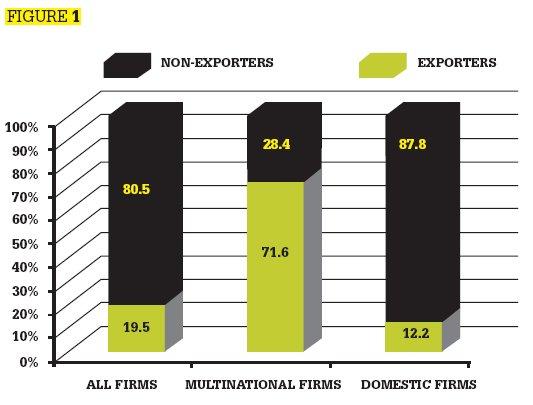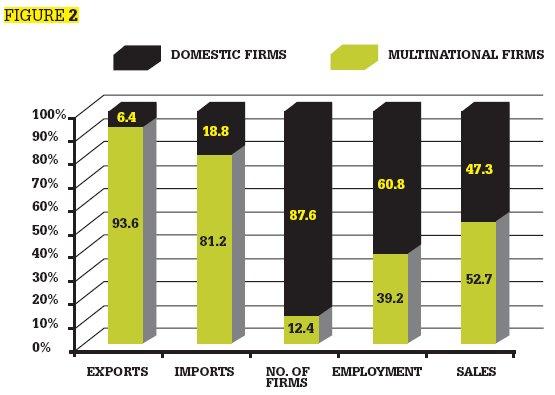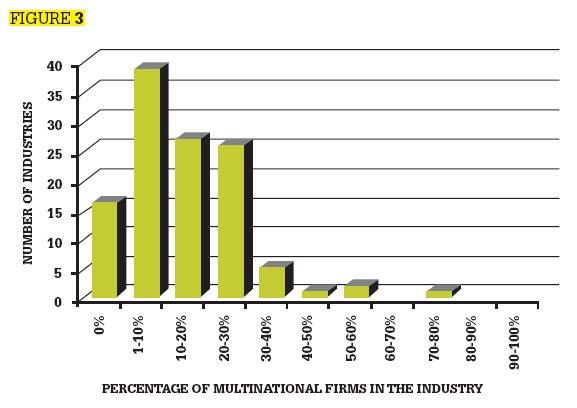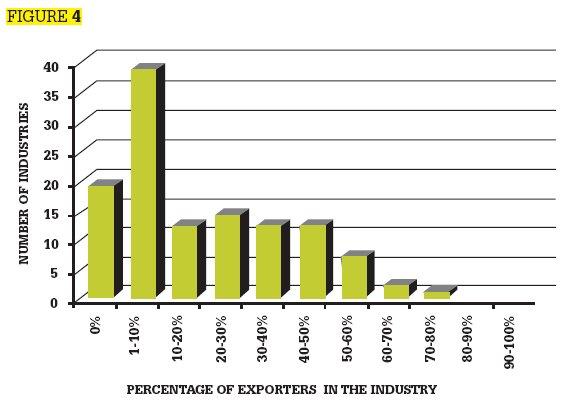Industry -- Global Sensitivity
By Kozo Kiyota
The influence of multinational firms in Japanese trade
When economists discuss the origins and implications of international trade, they usually focus on the role of comparative advantage of countries while paying relatively little attention to the individual firms. Despite the fact that many economists recognize the importance of international trade in the Japanese economy, the importance of the relationship between international trade and firms within Japan can often go unnoticed. Are exporters in the majority? Do multinational firms dominate Japanese trade? How influential are they in the Japanese economy? A recent study by Kiyota and Urata (2008) attempted to answer these questions.
Data
In the examination of these points, the study utilized the micro database of Kigyou Katsudou Kihon Chousa Houkokusho (The Results of the Basic Survey of Japanese Business Structure and Activities) prepared annually by the Research and Statistics Department, Ministry of Economy, Trade and Industry. This survey was first conducted in 1991, then again in 1994, and annually thereafter. The main purpose of the survey is to capture statistically a comprehensive picture of Japanese corporate firms with a particular focus on their diversification-, globalization-, R&D- and information technology- related activities.
The strength of the survey is its sample coverage and the reliability of its information. The survey is compulsory for manufacturing and non-manufacturing firms with more than 50 employees and with capital of more than 30 million yen (some non-manufacturing sectors such as finance, insurance and software services are not included). The survey covers 117 sub-categories of industries. The limitation of the survey however is that some information on financial matters is not available and that smaller-sized firms with less than 50 workers (or with capital of less than 30 million yen) are excluded.
From this survey, the study constructed a longitudinal (panel) data set for the years from 1994 to 2000. In the study, exporters are defined as firms whose sales are oriented toward foreign countries. Firms not classified as exporters are classified as non-exporters. Similarly, multinational firms are ones that own at least one foreign affiliate with equity of more than 1 million yen. Firms not classified as multinational firms are classified as domestic firms. Each year, the number of sample firms exceeds 22,000.
Are exporters in the majority? Figure 1 presents the share of exporters in 2000. Exporters are in the minority. As a percentage of all firms, exporters make up about 19.5 percent. More than 80 percent of firms sell their output to the domestic market only. In addition, international trade is closely related to the multinational status. Among multinational firms, more than 70 percent of firms engage in exports. On the other hand, nearly 90 percent of domestic firms are non-exporters. Figure 1
Do multinational firms dominate Japanese international trade? The answer is yes. Figure 2 presents the positions of multinational and domestic firms in Japan in 2000. Multinational firms accounted for 93.6 and
81.2 percent of total Japanese exports and
imports, respectively. The result clearly indicates that multinational firms dominated Japanese trade. Figure 2
It is also interesting to note that multinational firms and exporters are quite spread out across the industries. Figures 3 and 4 illustrate the distribution of industries by the shares of multinational firms and exporters. Each of the 117 sub-categorized industries is placed in one of the11 bars according to the percentage of multinational firms and exporters in that industry. Figures 3 and 4 indicate that the fraction of multinational firms and exporters that lies between 1 and 50 percent is 84 and 76 percent, respectively. This result suggests that in more than three fourths of all industries, there are always some multinational firms and exporters. Therefore, it is difficult to know to which industry multinational firms and exporters belong. Figures 3 & 4
How influential are multinational firms in Japanese economy? Figure 2 shows that multinational firms were in the minority in terms of the number of firms, accounting for 12.4 percent of total number of firms in Japan. However, in terms of the number of workers and sales, multinational firms represented a proportionally larger share, employing 39.2 percent of workers and transacting 52.7 percent of the sales, respectively. These results suggest that multinational firms are very influential in Japanese sales and employment, in addition to international trade.
Multinational firms directly employ nearly 40 percent of workers and have approximately 94 percent share of Japanese exports.
Implications
These findings have several important implications for Japanese economy and policy. First, the results present a reason why the Japanese economy is sensitive to the global business cycle despite the fact that multinational firms are in the minority in terms of the number of firms. Multinational firms directly employ nearly 40 percent of workers and have approximately 94 percent share of Japanese exports. The effects on Japanese trade thus affect more than one third of employment in Japan.
Second, trade policies that target “industry” may not be effective. Both exporters and multinational firms spread out across industries. Firms are quite heterogeneous in the sense that there exist some multinational firms and exporters in more than three fourths of all industries. Industry has less to do with exporting and multinational activities than standard trade models suggest. It is thus not surprising that industry-targeting trade policies are less effective than expected.
Finally, the development of firm-level data is important in understanding what is going on in the Japanese economy. The findings discussed above cannot be confirmed in industry-level data. Without firm-level data, it is difficult to know the link between international trade and the characteristics of firms. Industry-level data is useful when firms are homogenous in the same industry. When firms are heterogeneous even within the same narrowly defined industries, policy makers might design inappropriate policies if they analyze policies using industry-level data. The development of high-quality broad-coverage firm-level data will play an important role in designing policies to tackle economic problems. JI
Reference
Kiyota, Kozo and Shujiro Urata (2008) “The Role of Multinationals in International Trade: The Case of Japan,” Japan and the World Economy, 20(3): 338-352.
Dr. Kozo Kiyota is a professor at the Faculty of Business Administration, Yokohama National University. He can be contacted at kiyota@ynu.ac.jp
 Figure 1: Exporter vs. Non-exporter, 2000
Figure 1: Exporter vs. Non-exporter, 2000
 Figure 2: Multinational Firm vs. Domestic Firm, 2000
Figure 2: Multinational Firm vs. Domestic Firm, 2000
 Figure 3: Industry Intensity of Multinational Firms, 2000
Figure 3: Industry Intensity of Multinational Firms, 2000
 Figure 4: Industry Intensity of Exporters, 2000
Figure 4: Industry Intensity of Exporters, 2000





